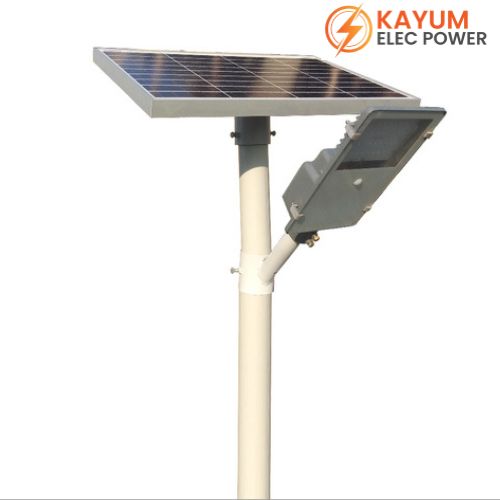
Transitioning to sustainable urban infrastructure is more than a trend—it is a necessity. Across Uttar Pradesh, municipalities and private developers are increasingly adopting solar semi-integrated street lights to enhance public lighting, reduce costs, and lower carbon emissions.
1. What Is a Solar Semi Integrated Street Light?
Semi-integrated street lights incorporate the LED lamp, energy storage (battery), and controller all within one luminaire, while mounting the solar panel separately on the pole above the lamp. This design promotes flexibility—you can angle solar panels optimally, swap components easily, and install larger panels for improved energy capture.
2. Why Uttar Pradesh Should Adopt Them
There are multiple reasons these systems make sense for Uttar Pradesh:
- Energy Savings: Entirely solar-powered, they eliminate electricity costs.
- Grid Independence: Ideal for rural and off-grid areas where power access is unreliable.
- Faster Deployment: No need for trenching or wiring, reducing installation time and cost.
- Carbon Reduction: Supports the state’s and country’s sustainability goals with clean power.
3. How They Work
1. Daytime Charging
The panel converts sunlight into electrical energy, stored in a battery (commonly Li-ion or LiFePOâÂÂÂÂÂÂ).
2. Dusk Activation
A built-in light sensor switches the LEDs on when ambient light falls below a threshold.
3. Lighting Modes
Configurable schedules are common—full brightness initially, dimmed later to preserve power.
4. Motion Sensor Option
Some models include PIR sensors for brightness boosts when movement is detected.
5. Battery Management
Controllers manage charging, prevent over-discharge, and protect battery health.
4. Technical Highlights
- Wattage Options: Systems typically range from 9W to 50W+, based on needs.
- LED Efficiency: Deliver approximately 120-140W light output.
- Durable Housing: Aluminum fixtures with IP65/66 ratings protect against dust and water.
- Battery Types: Lithium-ion and LiFePO batteries offer longevity and stability even in UP's climate.
- Advanced Control: MPPT or PWM controllers optimize charging and prevent energy waste.
- Optional PIR Sensors: Enhance energy efficiency and safety in low-traffic areas.
5. Manufacturer Highlight: Kayum Elec Power
With a decade of experience in sustainable lighting, Kayum Elec Power specializes in solar semi-integrated street lights tailored for Uttar Pradesh. Their designs focus on high-quality batteries, smart controls, and durability—emphasizing a “one-time investment, lifetime savings” ethos.
6. Real-World Applications in Uttar Pradesh
- Highways & Rural Roads: Consistent all-night lighting without grid power.
- Industrial Zones: Enables illumination of remote facilities and yards.
- Public Spaces: Parks, campuses, and parking areas benefit from solar independence.
- Schools & Campuses: Effective safe lighting without escalating energy bills.
- Remote Villages: Extend lighting to underserved and off-grid communities.
7. Cost & ROI Considerations
Initial Investment
Semi-integrated systems usually cost more upfront than conventional fixtures. However, eliminating trenching and wiring often reduces total project cost.
Operational Savings
- No power bills: Entirely solar-powered.
- Low maintenance: Modular units simplify servicing.
- Government Subsidies: UP offers up to 30% MNRE incentives, improving ROI.
Payback Period
Typically ranges between 2-5 years depending on system size, subsidies, and local electricity rates.
8. Site Selection & Sizing Guidelines
- Site Survey
Assess sunlight exposure, pole height, and local traffic patterns.
- Choose Wattage Wisely
Use 9-15W for residential paths; 30 50W for main roads and public areas.
- Select Battery Type
Invest in LiFePO for better performance in warm climates.
- Include Smart Controls
Opt for MPPT controllers and motion sensors to extend lifespan and efficiency.
- Ensure Certifications
Look for ISO, RoHS, and IP ratings to guarantee product resilience.
- Warranty & Support
Prefer vendors offering 3+ year warranties and local servicing.
- Leverage Subsidies
Choose systems eligible under MNRE schemes to reduce financial burden.
9. Installation & Maintenance Best Practices
- Panel Alignment: Mount panels facing south with a tilt of 20-30°.
- Pole Strength: Ensure poles support wind and environmental factors.
- Controller Setup: Configure dusk-to-dawn thresholds and sensor sensitivity.
- Keep Panels Clean: Remove dust and bird droppings every 2-;3 months.
- Battery Monitoring: Track voltage and plan replacements when capacity dips below 70%.
- Secure Wiring: Regularly tighten screws and inspect connections.
5 Frequently Asked Questions (FAQ)
Q1: How many hours of night lighting?
A1: With proper panel sizing and 6-8 hours of daily charging, expect 10-14 hours of illumination—enough to last through the night.
Q2: Do they perform well during monsoon or winter?
A2: Yes. Batteries store surplus energy on sunny days to buffer against cloudy periods. Some systems include dimmer modes to preserve power.
Q3: Can I upgrade components later?
A3: Absolutely. The semi-integrated design allows swapping panels, batteries, and sensors independently based on evolving needs.
Q4: Are motion sensors worth adding?
A4: Definitely—especially in low-traffic zones. They conserve energy and improve safety by increasing brightness only when needed.
Q5: What subsidies are available in Uttar Pradesh?
A5: The Ministry of New and Renewable Energy (MNRE) offers up to 30% subsidy on certified solar street light systems in UP, reducing upfront investment.
Conclusion
Solar semi-integrated street lights represent a smart, sustainable solution for Uttar Pradesh’s lighting needs. Their modular design, ease of installation, and cost-efficiency make them ideal for urban, rural, and industrial applications alike. With supportive government subsidies and the promise of long-term savings, these systems provide a resilient lighting alternative.


